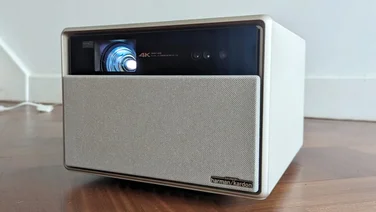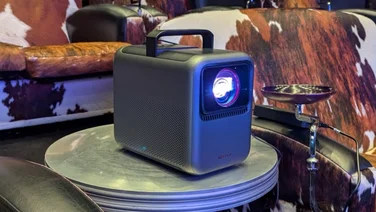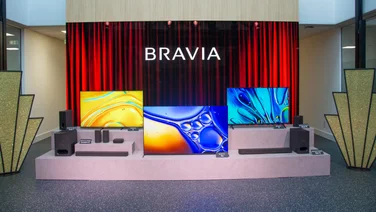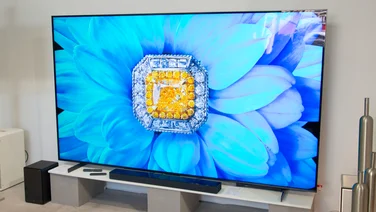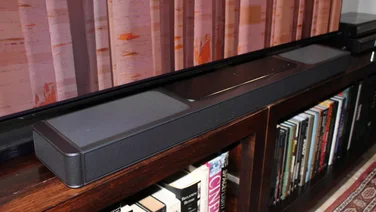To help us provide you with free impartial advice, we may earn a commission if you buy through links on our site. Learn more
- Sennheiser Ambeo Soundbar review: What you need to know
- Sennheiser Ambeo Soundbar review: Price and competition
- Sennheiser Ambeo Soundbar review: Design, features and connectivity
- Sennheiser Ambeo Soundbar review: App and setup
- Sennheiser Ambeo Soundbar review: Sound quality
- Sennheiser Ambeo Soundbar review: Verdict












- Best-in-class sound quality
- Spectacular DTS:X and Dolby Atmos performance
- Ambeo brings stereo content to life
- Extremely expensive
- Inconveniently large
- Doesn’t include rear speakers nor a dedicated subwoofer
Ambeo is a term coined by audio specialists Sennheiser to describe 3D audio. The German-based manufacturer offers a handful of products under the Ambeo umbrella, and the biggest quite literally is the Ambeo Soundbar.
One reason its so large is that, to bring the promise of 3D audio to life, the company has lobbed in no fewer than 13 drivers. And to help it deliver a truly cinematic experience, this top soundbar has full support for Dolby Atmos, DTS:X and MPEG-H 3D.
READ NEXT: Samsung HW-N950 review
Sennheiser Ambeo Soundbar review: What you need to know
The Ambeo Soundbar is a monster: Sennheiser hasnt constrained the size to that of your average-sized soundbar, which allows it to include an impressive array of drivers.












At its core, the soundbar has nine drivers facing forward, with a further two on the sides and another two at the top. This configuration allows it to project sound above and all around you, to give the full effect to the room-filling metadata used by as Dolby Atmos and DTS:X.
Unlike its rivals, however, the Ambeo-enabled soundbar doesnt come with a subwoofer or rear-facing speakers, which might well put off enthusiasts looking for a truly immersive experience.
READ NEXT: Best soundbars: Our favourite TV speakers
Sennheiser Ambeo Soundbar review: Price and competition
And make no mistake, this is a soundbar aimed at enthusiasts. At a cool £2,200 its the most expensive soundbar on the market.
It costs significantly more than my current favourite Dolby Atmos and DTS:X-enabled soundbar, the Samsung HW-N850, which can now be found for £658 (down from £1,100 when I originally reviewed it), and the HW-N950, which adds rear speakers to the mix for £1,179 (down from £1,500). One could also consider Samsungs later, more expensive models, the HW-Q80R and the HW-Q90R at £905 and £1,355, respectively, but both are near-identical to their predecessors.
If youre open to having cables running around the room, and even ceiling-mounted speakers, you might alternatively consider a set of passive floor-standing and bookshelf speakers that hook up to a receiver. Sets from Pioneer, Onkyo, Denon and Sony come bundled with audiophile-grade speakers for under £2,000, although you can spend a lot more if you wish. Some sound systems cost over £5,500: the skys the limit.
Sennheiser Ambeo Soundbar review: Design, features and connectivity
Lets start off by talking about the size, shall we? The Ambeo Soundbar is humongous. Its unlike anything Ive ever come across, measuring 13.5cm high, 17.1cm deep and 126.5cm wide. To put this in perspective, the Samsung HW-N850 is 8.3cm high, 13.5cm deep and 123cm long.
The bars size may be a problem if youd like to place it in front of your non-wall mounted TV as itll most likely obstruct the view. And you cant place it in a cabinet either as those upward- and sideward-firing speakers need open air around them to create the surround-sound effect.












There is the option to wall-mount the speaker, but for this youll need to purchase a £50 accessory and be strong enough to lift the 18.5kg bar into its mount.
In addition to all this, another large piece of equipment that youll have to factor into the equation is the 68cm-tall microphone thats used for room calibration. This sits on a rigid metal pole, so it can be awkward to store away; Bose and Sonos have much smaller stow-away solutions.












One aspect of the soundbar you cant fault is its build quality. It has a brushed-metal top plate, with metal grilles protecting the top-firing speakers and a hard fabric material that wraps around the front and sides. Its functional too: there are seven physical buttons at the top of the soundbar, an OLED display and a 2.5mm jack input for the calibrated mic at the front, with an illuminated Ambeo logo on the right. The latter can be dimmed or entirely turned off, though its nice to know when the Ambeo technology is actually active.












Sennheiser also includes a weighty remote, which provides everything you need when controlling the bar from afar. It has preset EQ profiles, volume and source controls, a one-click mute button and an Ambeo button that enables or disables the surround-sound effect.
For connectivity, the bar has a selection of ports underneath. Theres a female USB Type-A socket for media playback and charging; an HDMI eARC output; three HDMI inputs; one optical TOSLINK input; a coaxial subwoofer pre-out; and RCA auxiliary inputs.












Finally, theres an Ethernet port for an optional connection to your router. Connecting the bar to the internet lets you send Chromecast audio to it, and install firmware updates. You dont need a cable for this, though, as the bar also has built-in dual-band Wi-Fi.
Bluetooth connectivity is available too, although, the Ambeo Soundbar only supports the SBC and AAC codecs. The omission of the higher-quality aptX, aptX HD and LDAC codecs is unfortunate, but I suspect audiophiles will prefer for the Chromecast function anyway, as it can be used through popular media apps such as BubbleUPnP.
READ NEXT: Our favourite LCD, OLED and QLED TVs
Sennheiser Ambeo Soundbar review: App and setup
Once you manage to find a space for the bar, and have plugged in all the necessary connections, its time to get it running. The setup process is painless enough, but I found it odd that I was required to install both the Google Home app and Sennheisers own Smart Control app. The former is essentially required to connect the bar to your Wi-Fi network; Sennheiser tells me its looking to incorporate that capability into its own app at a later date.












The Smart Control app lets you toggle settings, adjust the Ambeo effect and check the bars connectivity status. One of the first things youll want to do is calibrate the soundbar to your rooms acoustics: to do this youll need to plug in the tall microphone and position it wherever youll be sitting, at head height. Once its in place, you can press and hold the Ambeo button on either the remote or the bar for four seconds to initiate the calibration. Its recommended you step away while its underway, so your body doesnt interfere with the acoustics of your room.
When the process is complete, the difference is like night and day. The overall sound quality is remarkably improved, and the surround sound effect is much more striking.
READ NEXT: The best Ultra HD Blu-ray players you can buy
Sennheiser Ambeo Soundbar review: Sound quality
Once calibrated, and with Ambeo enabled, the Sennheiser system delivers the best surround sound effect Ive ever heard from a soundbar. Its jaw-dropping, mind-bending and awe-inspiring. The combination of 13 large drivers and Sennheisers Ambeo 3D technology is fully vindicated.
If youre wondering what Ambeo actually does then, in a nutshell, it dynamically upmixes stereo content for a 5.1 surround sound system. For content thats encoded with height information (that is, Dolby Atmos or DTS:X) it also processes the audio for greater immersion.












This sort of virtualisation cant ever replicate a true surround-sound system with multiple speakers dotted around the room, but it works amazingly well. Ive seen many soundbars try to implement similar tricks, but none have done it as well as Sennheiser and that includes Samsungs HW-N950 and HW-Q90R, which come with rear speakers. This one really is the best in the business.
Indeed, the question is why youd ever want to disable it. I asked Sennheiser this, and was told that its in case you want to add the soundbar to a larger system or if youre a true purist wanting to listen to music in its raw 2.0 stereo form two of the front drivers and tweeters remain in action, only.












I tested Dolby Atmos performance using a demo disc supplied by Sennheiser, and I can confirm that Ambeo makes an incredible difference that you can really hear and feel. With the preset Movie EQ selected, the experience is exactly as if you were using a true 5.1.4 system. And that held true when I popped Transformers: Age of Extinction into my 4K Blu-ray player: I heard robots flying overhead, gunfire coming from the sides and speech thrown at me from the centre channel. A truly cinematic experience.
Of course, soundbars arent just made for movies, but for music too so I set the soundbar to Music mode and used the Chromecast function to try out a few of my favourite songs. Here, I was pleasantly surprised to find that the surround sound effect wasnt overdone. My current go-to test track 24K Magic by Bruno Mars really puts surround-sound systems to the test, as some struggle to separate the vocals from the instruments and lose the artists voice in the mix. The Sennheiser soundbar, however, gave a lifelike reproduction with an incredibly airy and open soundstage. No other soundbar Ive reviewed can match its prowess in this department.












The same could be said about its frequency response. High and mid-range frequencies arent recessed in the slightest, and provide plenty of energy in Calvin Harris Slide. Yet again, the soundbar provides best-in-class performance, with a much more engaging sound than the comparatively restrained-sounding Samsung HW-N850/Q80R and HW-N950/Q90R.
The Ambeo Soundbars weakest aspect is the bass. On one hand, the mid-bass frequencies are tight and controlled with plenty of grunt, but on the other, the sub-bass response lacks that heart-pounding rumble. Thats not to say the Soundbar is incapable of playing lower-end frequencies: on the contrary, it extends down to 30Hz, which is lower than competing soundbars from Samsung that include a dedicated subwoofer. Unfortunately, the Sennheiser Ambeo Soundbar simply fails to rattle the room with those low-end tones.
This ultimately detracts from the overall experience: I would recommend that, for the best musical experience, you should add a 10in or larger subwoofer to better handle sub-bass frequencies. When the appropriate subwoofer is connected, the crossover to the external speaker sits at 80Hz.
READ NEXT: Samsung HW-N850 review
Sennheiser Ambeo Soundbar review: Verdict
With or without a dedicated subwoofer, the Sennheiser Ambeo Soundbar is the best sounding all-in-one system Ive ever come across. It far surpasses the Samsung HW-N850, Q80R, HW-N950 and Q90R, which Id previously rated as the best soundbars money could buy. With support for Dolby Atmos and DTS:X, all the right connectivity inputs and outputs, a sleek remote control and a proprietary audio calibrator, its a fantastic package.
The price, however, is an issue. At £2,200, the Ambeo Soundbar is far more expensive than its all-in-one competitors, and sits in the same territory as full-blown surround sound systems. In addition, its size means it cant realistically be placed in front of any modern-day television, so itll have to be wall-mounted instead. And for me the biggest problem is the lack of a subwoofer; without it, youll be missing out on that heart-pounding experience youd expect from a premium audio system.
Ultimately, though, if youve got money to burn and youre willing to pay the extra for a dedicated subwoofer and a wall mount then you wont find a better all-in-one audio solution.

